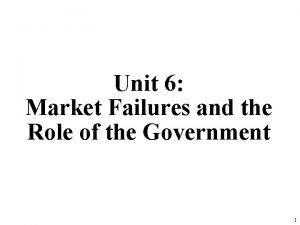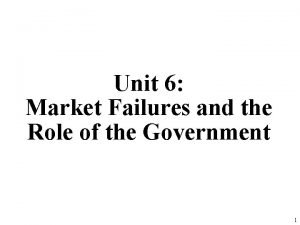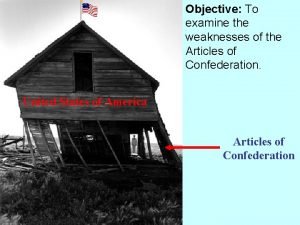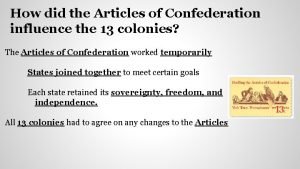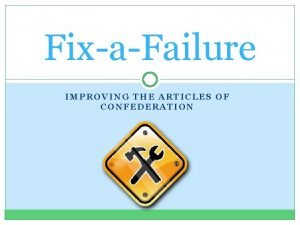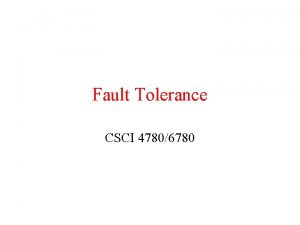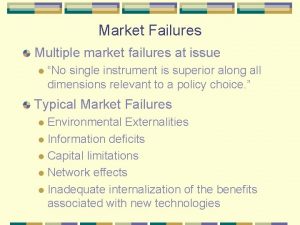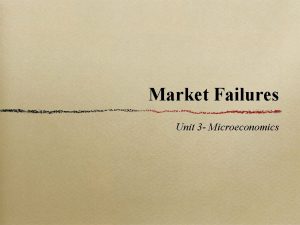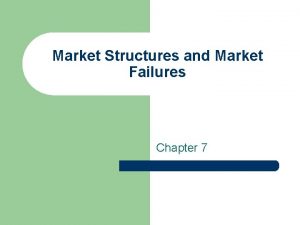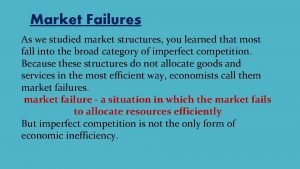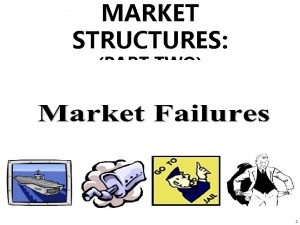Market Structures and Market Failures Structures of the














- Slides: 14

Market Structures and Market Failures

Structures of the Market Everything we have dealt with had been in a perfect scenario. What happens when the scenarios are no longer perfect and there are problems in the market?

What is Market Structure? Market structure – how the market is organized Based mainly on the level of competition in the market Key determinants: 1) Number of producers – more producers creates more competition Examples – clothing companies – many different producers of similar products Examples – Cell Phone companies – limited businesses to choose from 2) Similarity of products – more similar the products the more competition

What is Market Structure? Market structure – how the market is organized Based mainly on the level of competition in the market 3) Ease of entry – measure of how easy it is to start a new business in the market Markets that are easier to enter into are more competitive Example of limitation – start-up costs –cost needed to start a business in this market 4) Control of Prices – level of power producers have to control prices Called “market power” – ability to control market by controlling supply of goods.

In a perfect world: perfect competition The goal of any market is perfect competition lots of producers making similar products – benefits consumers If this is the case, prices stay close to equilibrium While the goal, it is incredibly rare Seen mostly with agriculture or commodities Commodities: products identical no matter who produces them – wheat, cotton, oil… This situation makes the producers price takers – producers that have to TAKE the prices paid Prices and information also easily accessible – With information comes time to do research Called the transaction cost: time and money consumers spend shopping for the best product at the best price.

Other Types of Market Structures 4 Different Types Perfect Competition – lots of similar products and producers Monopolistic Competition – similar products but with a brands and some powerful producers Oligopoly – limited products and a few very powerful producers Monopoly – only one producer of a unique product

What is monopolistic competition? Most common form of market structure There are many producers of a product, but the product varies Example – shoe companies – many brands, same product, but different style and quality of product Called product differentiation – products mostly similar but there is something that separates it Example – Nike Swoosh People become brand loyal – gives them greater market power Forces companies into non-price competition – convincing people their product is just as good or better Do this to try and gain market share – percentage of the market that they have Nike, Adidas and Reebok have large market shares in shoes

What is an oligopoly? Common, but less common than monopolistic competition Oligopoly: market dominated by a few powerful businesses E. g. – airline industry, oil & gas companies Companies have high degree of price control Can push up the price with price leadership – big company set price, others follow May use collusion – working together to set prices and levels of production May create a cartel – group of producers that set levels of production and prices Both illegal in the U. S.

What is a monopoly? Monopoly has only 1 producer in the specific market Relatively rare Creates highly imperfect competition Buyers have no control of prices at all Have high degree of price control because they are the only ones with a unique product Can create trusts: Combination of companies that make a unique product and work to control the prices Anti-trust laws – congressional laws passed to break up monopolies

The 3 Categories of Legal Monopolies 1) Resource monopolies 1 producer controls a natural resource; Others cant get in because they do not have access to the resource 2) Government controlled monopoly Created when gov’t gives exclusive rights to a product/service Patents and Copyrights – protects inventors from theft of their thoughts and ideas (limited) Public franchises – contract given to a firm to provide a service (E. g. : the National Park Service) Licenses – legal permit to operate a business 3) Natural monopolies One company can do things better, cheaper, faster than any other Seen as beneficial because of efficiencies – usually seen in utilities

Pros and Cons to Market Structure Benefits to perfect competition Forces producers to be as efficient as possible and consumers do not pay more for a product than what it is worth Negatives to monopolies Can cost consumers money Limits the desire to innovate and find better ways to do things Can lead to a lesser product in the end In between mixes these issues at different levels

When Markets Fail -- Inefficiencies Market failures – failure to clear quantity at the equilibrium price Imperfect competition – failure to allocate goods and services in the most efficient way Externalities – the side effects from producer/consumer relations Ex. when companies pollute or other effects to outsiders Two types of externality – positive & negative Negative is the cost to someone else outside producers and consumers Positive is the benefit to someone else outside the producers and consumers http: //www. stlouisfed. org/education_resources/economic-lowdown-videocompanion-series/episode-5 -externalities/ Public Goods

Public Goods – Used by All Public goods – goods & services used by everyone; not a specific person Ex. – Police/ Fire service, highways, etc. Private goods are excludable and are rivals in consumption Excludable means anyone who does not pay for the good/service can be excluded from using it. Rivals in Consumption means it cannot be consumed by two people at the same time Example – Your car, your goods – only you use them

Public Goods – Used by All Public goods are non-excludable and non-rivals in consumption Cannot exclude their use by those who are not paying for it E. g. One person’s use of a streetlamp does not diminish another’s ability to use the light as well. Example – street lights paid for with taxes – everyone benefits – not everyone pays taxes. Creates a free-rider problem – people not willing or not required to pay for things, but still benefit.
 Unit 6 four market failures
Unit 6 four market failures Unit 6 market failures and the role of the government
Unit 6 market failures and the role of the government Chapter 7 section 1 guided reading
Chapter 7 section 1 guided reading Define market failures
Define market failures Quasi public goods
Quasi public goods Perfect/pure competition definition
Perfect/pure competition definition Market failures
Market failures Successes and failures of the five year plans
Successes and failures of the five year plans Teaching market structures with a competitive gum market
Teaching market structures with a competitive gum market Articles of confederation fail
Articles of confederation fail Engineering ethics failures
Engineering ethics failures Vsi calibrated leak
Vsi calibrated leak Grading the articles of confederation
Grading the articles of confederation Problem with the articles of confederation
Problem with the articles of confederation Rpc semantics in the presence of failures
Rpc semantics in the presence of failures
